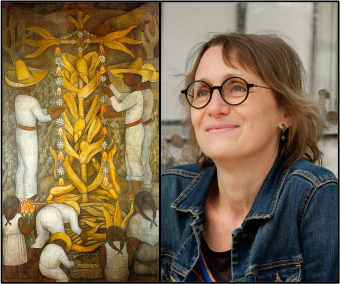
Maud TENAILLON
Genomics of domestication and crop adaptation
CNRS, Research Director
maud.tenaillon@inrae.fr — +33 (0)1 69 33 23 34
Genomics, Evolution and Adaptation of Domesticated plants
- Génétique Quantitative et Évolution - Le Moulon
- Université Paris-Saclay, INRAE, CNRS, AgroParisTech
- IDEEV
- 12 route 128
- 91190 Gif-sur-Yvette
My research focuses on understanding how evolutionary forces shape genetic variation of plant genomes. I have a specific interest for the domestication process. This process has resulted in a loss of diversity due to population bottleneck and selection at target loci. During my PhD, I addressed questions such as: What are the loci involved in the domestication syndrome in millet? What is the influence of the reproductive system on the organization of domestication genes? Since then, I’ve been focusing mainly on maize as a model species. I investigated the influence of recombination and selection in shaping diversity patterns in this species. I have worked both at a small scale to understand the interference between selective sweeps, and at a multilocus scale via coalescent simulations to model the demographic impact of domestication on diversity and linkage disequilibrium and, to identify selection targets. I have been working on questions related to variation in genome size within and between species in the Zea genus, both from a genomic - Transposable Element (TE) content - and from an ecological perspective (correlation with environmental variables). More recently, I investigated the role of admixture in adaptation, and discovered genomic regions with an unusual level of residual heterozygosity likely resulting from selection against inbreeding depression. I also adressed questions on local adaptation in natural populations of teosintes collected in Mexico. This work has resulted in the characterization of syndrome of adaptation to altitude thanks to common garden experiments, as well as the identification, through association mapping, of polymorphisms (both nucleotidic and TE insertions) involved in the phenotypic variation of these traits pointing to a role of inversions in the maintainance of this syndrome.

Ongoing projects
-
Experimental evolution in maize We conducted two divergent selection experiments for flowering date in two homogenous genetic backgrounds (inbreds) over 20 generations (Saclay Divergent Selection Experiments). The resulting populations display marked shifts in floral transition. We described a significant and continuous response to selection with two successive phases: fixation of residual heterozygosity and fixation of new mutations. This response translates at the transcriptomic level with evidence for genetic convergence between maize lines. We are now investigating dynamics of fixation and effects of mutations by combining simulations and association mapping. We are also questioning the impact of such phenological shifts on the root microbiome.
-
Maize-Bean intercropping
Unlike natural and human selection, which has acted for millennia in a multi-specific assemblage context, biotic interactions are minimized in modern agroecosystems. We focus on maize and bean, two crops that are still associated in some traditional European agricultural systems. We seek the potential benefits of this biological partnership which could result from complementarity and/or facilitation processes. We integrate field surveys, agronomic measures, rhizospheric metabarcoding, genetic tools to study the evolutionary history and the determinants of maize-bean intercropping. More generally, through the INCREASE project (https://www.pulsesincrease.eu/), we want to promote the description, preservation and use of the genetic resources of food legumes. Learn more about a really cool experiment on beans Citizen Science Experiment. -
Reproductive isolation between wild and domesticates Unlike plants cultivated by humans, their wild relatives have faced continuous challenges in their natural environment and exhibit greater genetic diversity. They thus constitute a reservoir of alleles which could be used to increase the adaptive capacity of cultivated species in the face of global changes. In this context, we ask questions about adaptive introgressions which contributed, for example, to the establishment of weedy teosintes in Europe, as well as about the establishment of reproductive barriers between wild and domestic forms. We combine modeling, genomic and experimental data (crosses and progeny evaluations) in a context of comparative analysis across 14 species. To know more.
Community
- Editor in Chief at Genome Biology and Evolution Epigenetics in Ecology and Evolution
- Co-animating local initiatives
Coordinating Master EvoGEM
Seminars: “Evolution en île de France”
Scientific committee: “GDR AIEM, Interdisciplinary approach of molecular evolution”\
Position and Education Full CV
- CNRS researcher, GQE-Le Moulon (2002-present)
- Awarded by the CNRS bronze medal in 2011
- Visiting researcher in the Gaut lab at UC Irvine CA (2009-2011)
- HDR defended 2009 (University Paris-Sud)
- Postdoctoral fellow in the Gaut lab at UC Irvine CA (1999-2002)
- Master and PhD student, Dpt. Evolution and Systematics, University Paris-Sud (1995-1999)